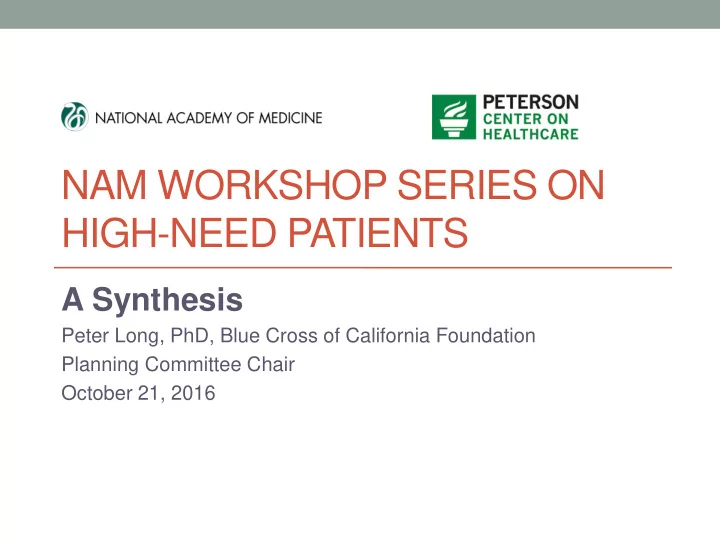

NAM WORKSHOP SERIES ON HIGH-NEED PATIENTS A Synthesis Peter Long, PhD, Blue Cross of California Foundation Planning Committee Chair October 21, 2016
2 Topics 1. Where we started? 2. Where we’ve been? Recap from workshops 1 and 2 Workshop 2 – present 3. Recap from today 4. Main themes and conclusions 5. A path forward
3 Where we started? NAM Peterson CMWF HSPH Center BPC Collective goal: Advance our understanding to better manage health of high-need patients through exploration of patient characteristics and groupings, promising care models and attributes, and policy solutions to sustain and scale care models.
4 Where we’ve been? Jan ’16: Workshop #2 Feb’ 15: Initiative Launch You are here. March ‘17: NAM July ‘15: publication Oct ‘16: Workshop #1 Workshop #3 • Review and dev’t of patient taxonomy • Review of care models • Identification of areas of opportunity for policy action
5 Recap: Workshop 1 • At the first workshop, we framed the problem and issues: • Who are “high-need patients” and what are their shared characteristics, needs, and challenges? • What do successful care models for the treatment of these patients look like? • What are challenges with the sustainability, spread, and scale of these successful programs?
6 Recap: Workshop 2 • At the second workshop, we delved deeper into: o Existing data on high-need patients Insights into patient characteristics and care utilization Data sources, including limits and opportunities of available data o Segmentation of patients Synthesis of what we know Utility of segmenting patients to target care Potential implications for care delivery and policy o Distilling key design elements of successful care models Common design elements across care models Barriers to broad adoption o Considerations for spread and scale of care models Strategies Barriers
7 Recap: Additional Workgroup Activities • Convened taxonomy workgroup to review existing approaches and provide guidance on adaptation and application in practice. • Reviewed literature on care model to identify promising models and attributes. • Mapped care models to different high need patient segments. • Identified areas of policy opportunity.
8 Recap from today…
9 U.S. .S. N News NEW YORK, MONDAY, APRIL 3, 2017 Bold action needed to im prove care for high-need patients, reduce costs A number of promising innovations in care delivery have emerged based on a review of research on caring for high-need patients, but they face systemic barriers to replicating and sustaining the key practices. To make progress – and address one the most expensive and challenging populations for the current health care system— bold action is needed to improve the policy environment and care delivery. It is essential to create a policy and regulatory environment built around payment models that incentivize coordinated care and support the integration of clinical care and social services. Health systems would benefit from a “taxonomy” to segment high-need patients and match the appropriate interventions, as well as a set of key measures to support value-based payment.
10 Main Themes and Conclusions • The high-need patient population is diverse, complex, expensive, and transient. • One size doesn’t fit all. We need to strike a balance between standardized and customized approaches to care. • Segmenting patients is one tool to target care and should be tested in more real-world settings in conjunction with care models that have been shown to work. • The solutions (e.g., tools, data, care models, policies) must extend beyond the medical because social and behavioral factors are essential to address. • In order to be actionable, policy solutions must account for existing system constraints and complexities (e.g., integration of medical + social, financing of care models).
11 A path forward • More research and better data are needed to bolster the evidence base for care models that work. • There are major policy barriers to broad implementation of what we already know DOES work. -- In the meantime, action is needed now – • Health systems need to work with payers to better identify and target high-need patients and test new practices (i.e., taxonomy). • Payers need to actively support the adoption of care models (or specific elements) that we know work. • Policymakers and payers need to continue progress toward a value-based system , using alternative payment models (including those that work within FFS structure) to support more effective care for high-needs patients.
12 Now, we turn to you to receive your feedback and counsel.
Recommend
More recommend